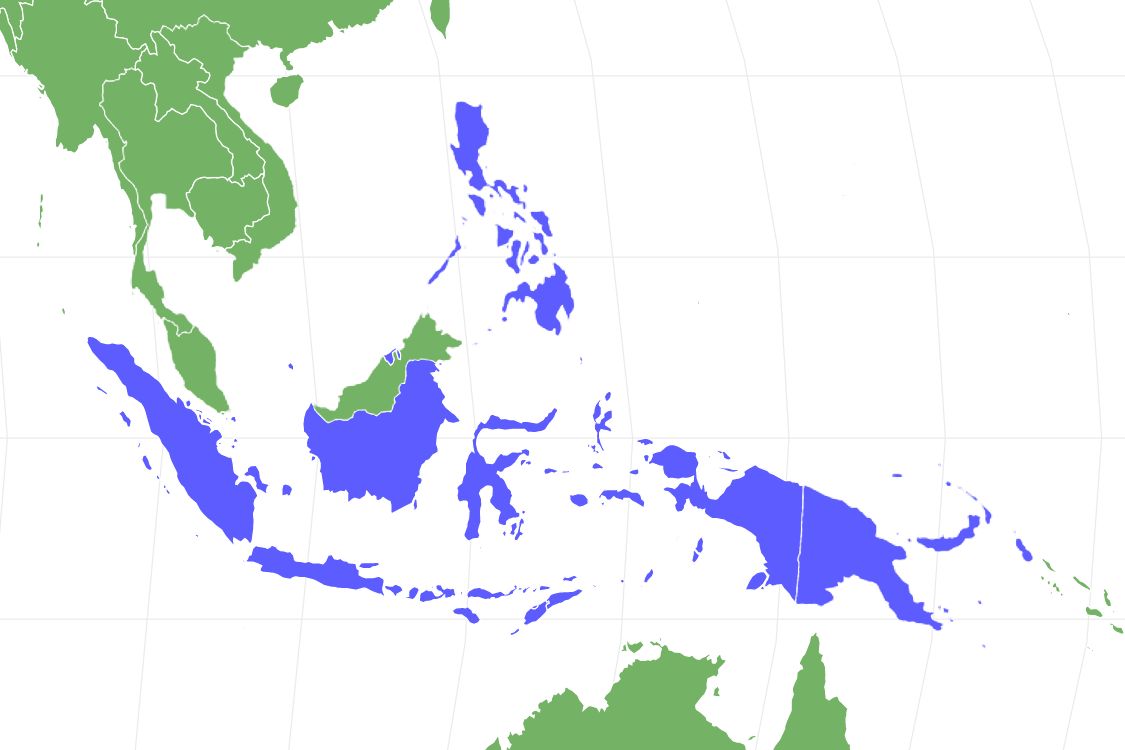Tarsier
Tarsius
Each eye weighs more than their whole brain!
Advertisement
Tarsier Scientific Classification
- Kingdom
- Animalia
- Phylum
- Chordata
- Class
- Mammalia
- Order
- Primates
- Family
- Tarsiidae
- Genus
- Tarsius
- Scientific Name
- Tarsius
Read our Complete Guide to Classification of Animals.
Tarsier Conservation Status
Tarsier Facts
- Prey
- Insects, Lizards, Birds
- Name Of Young
- Infant
- Group Behavior
- Solitary/Group
- Fun Fact
- Each eye weighs more than their whole brain!
- Estimated Population Size
- Declining
- Biggest Threat
- Habitat loss
- Most Distinctive Feature
- Long and powerful hind legs
- Other Name(s)
- Western Tarsier, Eastern Tarsier, Philippine Tarsier
- Gestation Period
- 180 days
- Habitat
- Forests, mangroves and scrub
- Predators
- Cats, Snakes, Birds of Prey
- Diet
- Carnivore
- Average Litter Size
- 1
- Lifestyle
- Nocturnal
- Common Name
- Tarsier
- Number Of Species
- 18
- Location
- A number of south-east Asian islands
- Slogan
- Each eye weighs more than their whole brain!
- Group
- Mammal
Tarsier Physical Characteristics
- Color
- Brown
- Grey
- Golden
- Skin Type
- Fur
- Top Speed
- 24 mph
- Lifespan
- 12 - 20 years
- Weight
- 80g - 165g (2.8oz - 5.8oz)
- Height
- 9cm -16cm (3.6in - 6.4in)
- Age of Sexual Maturity
- 1 - 2 years
- Age of Weaning
- 8 weeks
View all of the Tarsier images!
The Tarsier is one of the most unique primates on the planet. It is known to have the largest eyes of any mammal in relation to its body size. Each eye is actually heavier than its brain!
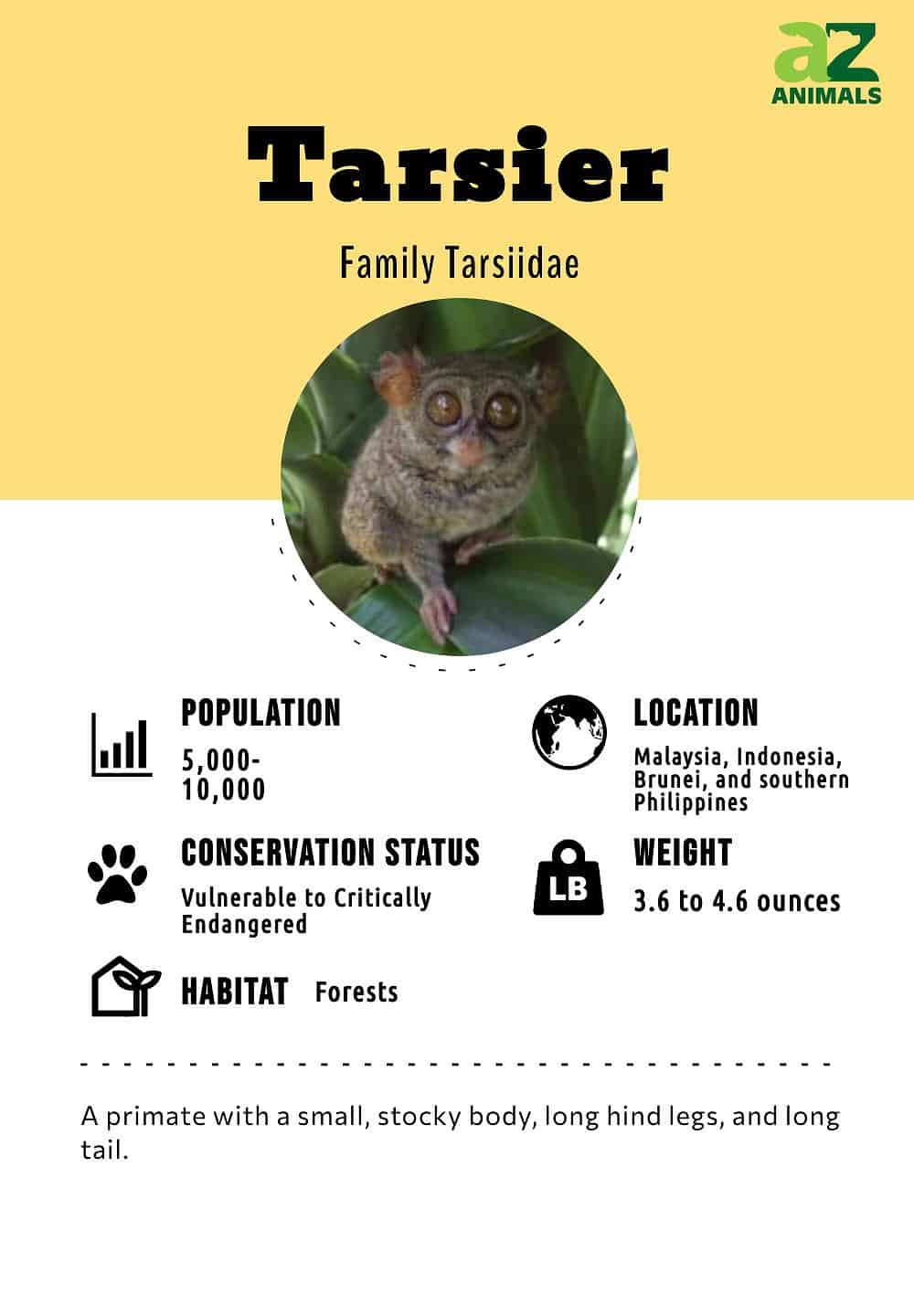
3 Interesting Facts:
- The Tarsier has an unusually long anklebone that enables it to jump distances more than 40 times its own body length. The bones are known as the Tarsals, which is where the Tarsier gets its name.
- Females are known to give birth to the largest babies in relation to their adult size.
- The Tarsier is known to be quite unique geographically because of its distribution across Wallace’s Line, which runs south between Borneo and Sulawesi and separates the evolutionary centers of the animals found in Eurasia and Australia. Generally, animal species tend to be found on only one side of Wallace’s Line, but the Tarsier is found on both.
Classification and Evolution
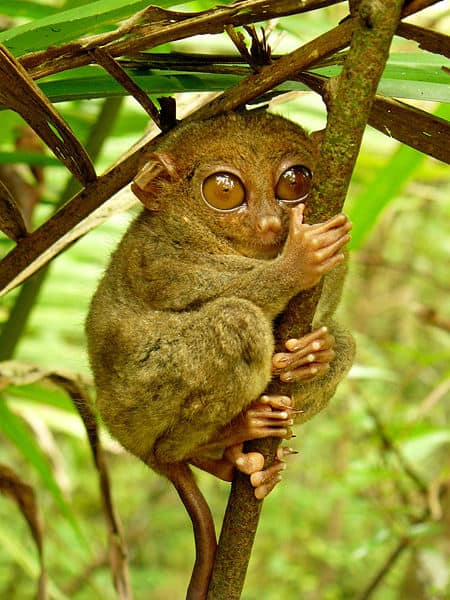
This Tarsier is part of the Phillipine Tarsiers and a member of the Family Tarsiidae.
The Tarsier is a small species of primate that inhabits the well-vegetated forests of a number of islands in southeast Asia. Although fossil records show that Tarsiers once could have been found in mainland Asia, Europe, North America, and Africa, modern Tarsiers are today restricted to just a handful of islands in Malaysia, Indonesia, and the southern Philippines. These fossil records show that Tarsiers have existed for 55 million years, and have had very few developmental changes in the last 45 million years.
As a member of the Primate order, the Tarsier is in the Suborder Haplorhini (which means dry nose), the Infraorder Tarsiiformes, and the Family Tarsiidae, of which Tarsier is the only member. After that, there are three genus categories: Carlito, Cephalopachus, and Tarsius.
Otherwise, there has been constant debate amongst scientists over the naming and classification of the different Tarsier species. There appear to be from 13-19 different subspecies of Tarsier that are split into three groups generally depending on their geographic location: Western Tarsiers, Eastern Tarsiers, and Philippine Tarsiers.
Although science is slowly discovering more and more about Tarsiers in the wild, data can be hard to collect due to their shy and elusive nature. Add to that the constant confusion over the classification of separate species, and conservation efforts become difficult.
Anatomy and Appearance
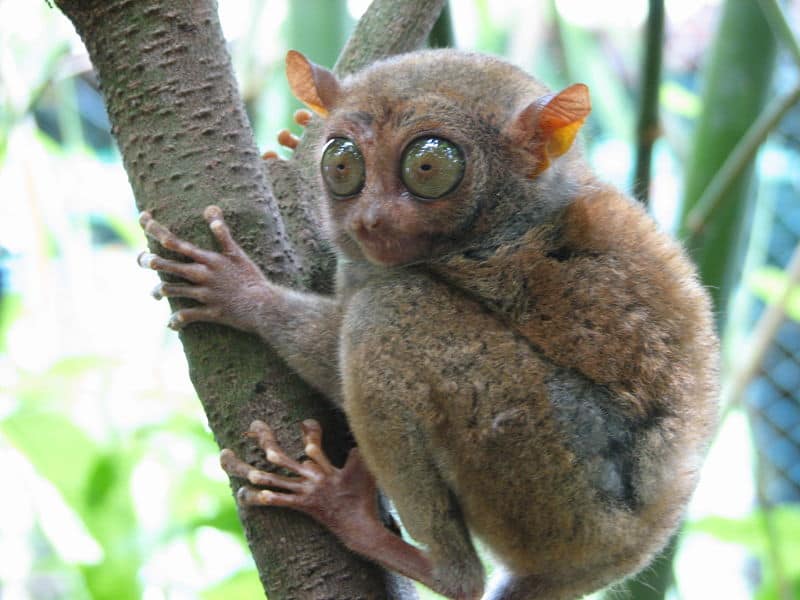
Tarsiers have long fingers and toes that are tipped with pads and nails to help them grip onto branches and prey.
The Tarsier is a unique and distinctive looking animal that has a number of specific features to aid its nocturnal and arboreal lifestyle. Although the exact appearance of the Tarsier may vary slightly between species, all are relatively similar with a small, stocky body and long tail that is either sparsely covered in fur or has a tuft at the end.
Their very soft fur varies among grey, brown, and ochre in color, depending on the species, but all Tarsiers share the characteristic long hind legs that enable them to leap distances of up to 16.5 feet (5 meters) between branches. The long fingers and toes of the Tarsier are tipped with pads and have nails to help them grip onto branches and prey.
The most distinctive features of the Tarsier though can be found on its head that, thanks to specially adapted vertebrae, are able to turn 180 degrees in both directions. Therefore, this primate can see behind itself without moving its body.
The enormous eyes can be up almost two-thirds of an inch across. They enable the Tarsier to hunt for prey and watch out for predators in the dark. Tarsiers also have large bat-like ears that are incredibly sensitive and able to detect even the slightest sounds close by.
Distribution and Habitat
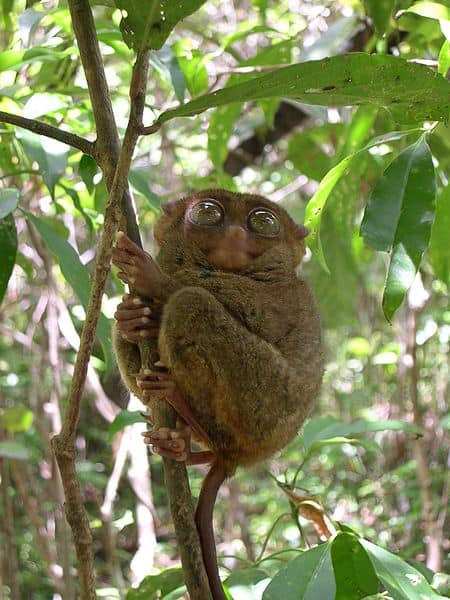
Tarsiers ae losing their forest habitats in southeast Asia.
©Magalhaes – Public Domain
Although they were once found on four continents, today Tarsiers are restricted to a number of islands in southeast Asia.
- Western Tarsiers animals are generally found in lowland primary forests or low mountain forests on the islands of Borneo, Sumatra, Bangka, Belitung, Kalimanta, and small surrounding islands.
- Eastern Tarsiers can be found only on Sulawesi and the surrounding islands but seem to be more adaptable to habitats at different levels of forest. The exception is the Pygmy Tarsier which is restricted to very high mountainous forest.
- Philippine Tarsiers tend to prefer lowland forests and are distributed across southern Philippines islands such as Bohol, Samar, Leyte, and Mindanao.
Despite there being limited information about the distribution of subspecies in particular, the general population trend is thought to be declining, primarily due to habitat loss and fragmentation of such small and unique island ecosystems.
Behavior and Lifestyle
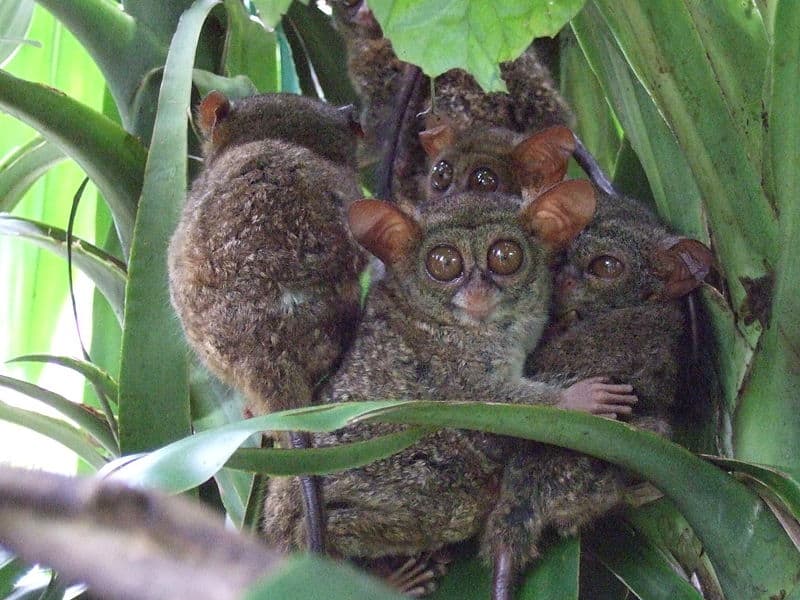
Tarsiers are relatively solitary in the wild, but these tarsiers live more closely together in a zoo.
Until recently it was thought that all Tarsiers were solitary. However, recent research has shown that social behavior varies among the different species. Eastern Tarsiers are the most sociable and spend time in groups of two or three individuals. Western Tarsiers appear to be more solitary, only coming together to mate.
Tarsiers spend most of their lives clinging to tree branches where they rest during the day. However, Tarsiers are incredibly unique amongst primates because they do not climb or move about in search of food. Instead, they cling onto a tree branch where they can turn their heads dramatically to survey their surroundings. They then use their incredibly powerful, long hind legs to help them to leap to another branch or to pounce on prey with their padded fingertips and claws, providing them with essential grip when landing.
Tarsiers are also relatively vocal animals, and although the number and frequency of calls depend on the species, it is often the easiest way to identify one Tarsier subspecies from another, with different vocalizations being used for different situations.
Reproduction and Life Cycles
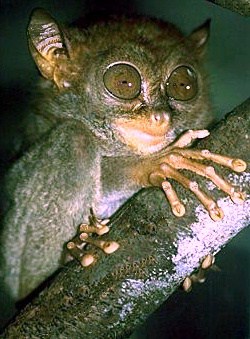
Tarsiers are able to reproduce by the age of two and are able to breed all through the year.
Tarsiers are able to breed all year round with females giving birth to a single baby after a gestation period that lasts for about six months. The exception is the Eastern Tarsier (the Spectral Tarsier) that has two breeding seasons between April and May, and then October and November.
Baby Tarsiers are very well developed and are born with a full coat of fur and open eyes They are able to climb at just a day old. The female Tarsier suckles her young for around two months; then the infant begins eating an adult diet. Some are able to hunt independently of their mother before they are even a month old.
Tarsier infants are carried around in their mother’s mouth or cling onto her fur. Once they can hunt on their own, young Tarsiers leave their mother to establish a territory of their own. They are usually able to reproduce between one and two years old. The lifespan of Tarsiers depends on the species, but the Philippine Tarsiers are thought to live 20 years, whereas the Western and Eastern Tarsiers can live 15 years and 12 years respectively.
Diet and Prey
The Tarsier is also unique in that it is the only completely carnivorous primate in the world. Under cover of night, Tarsiers cling to tree branches while waiting motionlessly but using their night vision and sensitive hearing to locate food. Then the Tarsier moves slightly closer to its prey before leaping onto it and catching it with its front hands. The long fingers and toes of the Tarsier enable it to also trap flying prey mid-air and provide an almost cage-like device to prevent it from escaping before the Tarsier has killed it. Insects make up the bulk of a Tarsier’s diet, along with small vertebrates such as frogs, lizards, and small birds. Some Tarsier species will even hunt poisonous snakes and can actually catch small bats in the air. Tarsiers hold their prey in their front hands to eat it with their strong jaws and teeth. Their mouths, which are wide for their small size, enable them to consume larger prey.
Predators and Threats
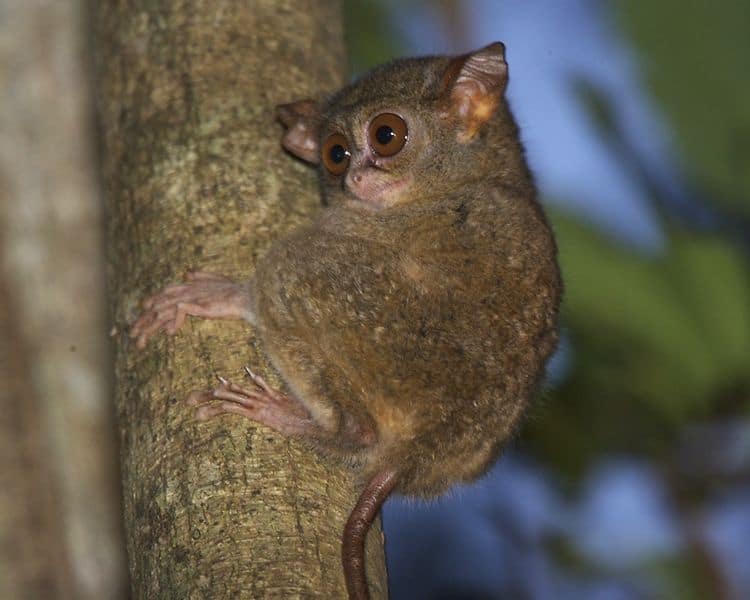
This Spectral Tarsier, like other tarsiers, is a greatest risk from human encroachment on the forests.
Since the Tarsier is small, it is preyed upon by numerous animal species in the surrounding forest including cats, birds of prey, large snakes, and small carnivores. Tarsiers can keenly sense the presence of a potential predator and often use their strong hind legs to leap to a safer branch.
However, the remaining Tarsier populations are at greater risk from people than anything else, primarily in the form of the degradation and fragmentation of their habitats. Forest clearance for agriculture and mining, and land clearance for livestock grazing has led to drastic declines in their population numbers. They are also often captured for the exotic pet trade but many die within a matter of days due to the lack of live food or suitable sleeping sites.
Relationship with Humans
The Tarsier is an incredibly elusive animal that is known to be particularly shy around humans. With increasing human activity in areas throughout much of their natural range, Tarsiers are being pushed into smaller and more isolated pockets of their once extensive and rich habitats. They are not particularly adaptable to areas of degraded forest because of a lack of food and trees where they can sleep and sit to watch for prey or predators.
A possible factor for the drastically declining populations of the Siau Island Tarsier is that local people hunt them for food, which along with their very restricted range on their island, has led to them being classed as one of the 25 most endangered primates in the world.
Conservation Status
Today, many of the different Tarsier species are either listed as being Endangered or Vulnerable by the IUCN with a number (including the Siau Island Tarsier) being listed as being Critically Endangered in the their natural habitats. Some species are listed as Data Deficient by the IUCN because of a lack of information about their status in the wild.
Although conservation work, particularly in the Philippines, is striving to protect these animals and their remaining pockets of primary forest, they remain threatened by loss of habitat throughout much of their natural range. Captive breeding programs are quite unsuccessful as only about 50% of Tarsiers captured are said to survive in their new homes. The reasons for this failure to thrive are a lack of live food, a high infant mortality rate, and a slow reproduction rate in zoos.
View all 133 animals that start with TTarsier FAQs (Frequently Asked Questions)
Are Tarsiers herbivores, carnivores, or omnivores?
Tarsiers are Carnivores, meaning they eat other animals.
What Kingdom do Tarsiers belong to?
Tarsiers belong to the Kingdom Animalia.
What class do Tarsiers belong to?
Tarsiers belong to the class Mammalia.
What phylum to Tarsiers belong to?
Tarsiers belong to the phylum Chordata.
What family do Tarsiers belong to?
Tarsiers belong to the family Tarsiidae.
What order do Tarsiers belong to?
Tarsiers belong to the order Primates.
What type of covering do Tarsiers have?
Tarsiers are covered in Fur.
What genus do Tarsiers belong to?
Tarsiers belong to the genus Tarsius.
Where do Tarsiers live?
Tarsiers live in a number of southeastern Asian islands.
In what type of habitat do Tarsiers live?
Tarsiers live in forests, mangroves, and scrub.
What are some predators of tarsiers?
Predators of tarsiers include cats, snakes, and birds of prey.
How many babies do Tarsiers have?
The average number of babies a Tarsier has is 1.
What is an interesting fact about Tarsiers?
Each of a Tarsier’s eyes weigh more than their whole brain!
What is the scientific name for the Tarsier?
The scientific name for the Tarsier is Tarsius.
What is the lifespan of a Tarsier?
Tarsiers can live for 12 to 20 years.
How many species of Tarsier are there?
There are 18 species of Tarsier.
What is the biggest threat to the Tarsier?
The biggest threat to the Tarsier is habitat loss.
What is another name for the Tarsier?
The Tarsier is also called the western tarsier, eastern tarsier, or Philippine tarsier.
How fast is a Tarsier?
A Tarsier can travel at speeds of up to 24 miles per hour.
What are the differences between tarsiers and aye-ayes?
The most distinct feature about tarsiers is their eyes, which are more prominent in proportion to the rest of the body. Other key differences between the two animals include their size, distribution and habitat, and diet.
How to say Tarsier in ...
Thank you for reading! Have some feedback for us? Contact the AZ Animals editorial team.
Sources
- David Burnie, Dorling Kindersley (2011) Animal, The Definitive Visual Guide To The World's Wildlife
- Tom Jackson, Lorenz Books (2007) The World Encyclopedia Of Animals
- David Burnie, Kingfisher (2011) The Kingfisher Animal Encyclopedia
- Richard Mackay, University of California Press (2009) The Atlas Of Endangered Species
- David Burnie, Dorling Kindersley (2008) Illustrated Encyclopedia Of Animals
- Dorling Kindersley (2006) Dorling Kindersley Encyclopedia Of Animals
- David W. Macdonald, Oxford University Press (2010) The Encyclopedia Of Mammals
- Tarsier Information, Available here: http://www.endangeredspeciesinternational.org/tarsiersection.html?gclid=COf8lpyc5q0CFQlpfAodl0sz9Q
- Tarsier Conservation, Available here: http://www.iucnredlist.org/apps/redlist/details/21491/0

